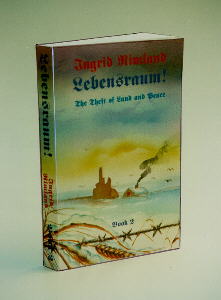

A review by Helmut Becker
The middle volume of Ingrid Rimland's trilogy, LEBENSRAUM, unfolds the full extent of the tragedy which is to befall the German settlers living in the Ukraine in the wake of the Bolshevik Revolution of October 1917. At the invitation of Catherine the Great, Empress of Russia, they had settled and pioneered the land a hundred years before and worked it hard while professing their deep-rooted faith within their close-knit community. They pledged their allegiance to the Russian Czar, but maintained their German customs, language and religious tradition of pacifism and hard work. They prospered from generation to generation to the envy of some of their neighbors. Ingrid Rimland paints a stunning canvass of tranquility, prosperity and peace, but one with ominous signs of revolution brewing under the surface.
Book II begins with the outbreak of World War I. At first, life in Apanlee, as the German settlement in the Ukraine is called, continues undisturbed, except for the wild rumors flying from the far distance and for the increasing defiance demonstrated by Hein Neufeld's bastard son, Dominick. The news of the war is received with disbelief in peaceful Apanlee: It could not happen - the Kaiser and the Czar were cousins.
Through the menacing character of Dominick, Rimland creates an eerie mood just before the Revolution reaches Apanlee. At one point, when he returns home on furlough from the war, he behaves animal-like in his threatening attacks toward his siblings, waiting for the right moment to devour his victims. He owns nothing; the Neufelds are rich; he does not hide his intention to take it all away from them - in the name of 'EQUALITY' - as the revolution proclaimed. In his hatred, he views them as the enemy. They still speak German and have taken away the land and, thus, the grain from the Russian worker.
Much of the gathering strength of the Russian Bolshevik Revolution is seen through the eyes and actions of Dominick. Freed from jail after some thievery and full of hatred for the Czar, the landowners and the Germans, he joins a marauding band, led by a legendary outlaw, Nestor Machno, savaging everything in its path. Rimland draws a grim picture of the country falling deeper and deeper into a state of anarchy... bodies hanging from trees, lying in the mud, blood flowing, churches, houses, granaries burning, unspeakable horror, children numbed by hunger and brutality. The New World Order has begun. The story, as told by Rimland, reflects the whole range of hatred, cruelty, scum of the earth bestiality that was the Russian Revolution. Many die or are shipped to Siberia.
Meanwhile in Mennotown near Wichita, founded by Jan Neufeld and his mother, life continues to prosper. However, as America enters the war against Germany in 1917, it becomes evident that the loyalties of the German settlers toward either Russia or Germany had declined; they were Americans now. This skillfully woven parallel thread between the Ukrainian and Kansas branches of the Neufeld and Epp clans continues throughout the second volume.
In the Ukraine, the dismal life on the collectivized farms of Apanlee continues. Russia after the revolution is a desolate place of terror and famine. Faith is what keeps the Germans alive, yet this faith must be kept secret, lest one is executed for believing in God's mercy. With much sensitivity and insightfulness born of her own experience, Rimland provides masterful descriptions of the horrors of Bolshevik rule through the eyes of Marleen, the matriarch of the German colony, Natasha, her husband's former lover and maid, and the four surviving children.
After their prosperous life during the roaring twenties, the Epps and Neufelds in Mennotown in Kansas have their own troubles during the dust storm-plagued thirties. Again, Rimland captures accurately the mood of the country after the stock market crash of 1929 with the great depression coming into full swing, the homeless, the long bread lines, bankruptcies and bank closures, people jumping out of windows. Everyone suffers, except the mythical Jews who even now seem to have money to lend.
Jan Neufeld watches his crops being destroyed by the incessant storms of the dustbowl. He is being hounded by creditors. And when an arson fire destroys his mill, silos and stables, his spirit breaks. He applies at the bank for a government "New Deal" loan and is turned down. Creditors repossess his farm machinery. In an act of desperation, Jan shoots his cows and gets drunk with his friend Doctorjay, despite the fact that he had never touched a drop of alcohol before in his life. He ends up in Preacher Dewey Epp's soup kitchen, and when a zealous reporter takes a picture of Jan as a prime example of the homeless's plight, his stretched nerves snap and he kills Dewey Epp. Jan is jailed and commits suicide.
The funeral is not yet over when the bankers close in to auction off Jan's property, which now belongs to his widow, Josie. Through a brilliant speech, Doctorjay induces the townfolks to bid down instead of up in this auction. The bankers end up with little or nothing, and Josie, the widow, can keep the house. Thus ends Volume II in a ringing crescendo, but with an upbeat note.
Throughout this volume, Ingrid Rimland exhibits her immense skills of story telling.